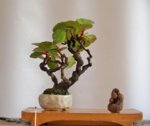evolutionrevolution
Mame
Can anyone recommend a product for repairing a cracked / broken ceramic pot?

Same here.Ive fixed a couple with Gorrila glue.
Well, I claim to be no expert on wabe sabe.Sifu,
the last time someone explained the real meaning of Wabi Sabi,
it came of as poor folk playing mind games.
Talk to Russell Coker, Mellow Mullet knows him and he is around your area.
He had written proof and his words are on IBC.
The pot was repaired by K because he could test his Chemistry.
We do pottery more through Chemistry than a dash of this or that.
As you know ----------- we like to make or do for ourselves, pottery needs chemistry.
Plus, that was his first pot fired in his first Kiln [ 17 years old ] and it was a small Paragon.
Still has it.
There is more that one way to save memories.
To be frank, if I had a 300 year old pot, I would treat it with respect.
I doubt I would use it for Bonsai, maybe incense.
But I would find that pot use very disrespectful to the potter.
I treat my tea pots the same way. Curio Cabinet and for special guests to be served from.
With white or hand ground green tea.
Good Day
Anthony
Hey @Ericc ,
this one, if only for you to have a good laugh.
Bought a very thin commercial bonsai pot, it split apart.
Going to see if we can not only fix it, but thicken it.
The Frit bit on wiki, brought back memories.
The 10.1.1 recipe, we have a super plastic clay, that can plasticize,
the sand and frit.
Not quite white, but can be used to hand build on a small turn table
[ the one for use with applying overglaze paint ] really beautiful
objects.
Also great for Egyptian Paste.

